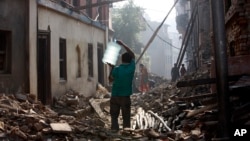Nepal has been overwhelmed by its second massive earthquake in less than three weeks, its prime minister said Thursday as he visited this normally placid foothills town, now a center for frightened villagers desperate for government help.
Thousands of people now crowd the streets of Charikot, the administrative center of the isolated district hit hardest by Tuesday's magnitude-7.3 quake, which killed at least 96 people and injured more than 2,300. The magnitude-7.8 earthquake that hit April 25 killed more than 8,150 people, injured tens of thousands more and left hundreds of thousands homeless.
"After the first quake, we were not prepared for a second one so big," Prime Minister Sushil Koirala told reporters after arriving in Charikot by helicopter.
The challenges the government faces have been compounded by extensive damage to the Singha Durbar government complex in Kathmandu, parts of which are now so unstable they can no longer be used.
In responding to criticism about the government's response, the prime minister's spokesman, Uttar Kumar Khatri, told the French news agency AFP even his team was now operating out of a tent, calling it a "difficult situation."
Monsoon season
Koirala said the coming monsoon rains now loomed large, with hundreds of thousands of people left homeless.
"We need tents. Our people need shelter. With the rainy season, it will be difficult for people to survive in the open," he said.
Nearly everyone is too afraid to sleep indoors in Charikot, which is filling with people from surrounding areas seeking help. Aftershocks are keeping them on edge.
While food has been handed out occasionally here, supplies were nowhere near enough for the people who kept arriving. Many people simply waited at the locked gates of the army's small aid distribution center, shaking the fence angrily when their frustration got the better of them.
"We came here with such hopes and such difficulty, but now we're just waiting and waiting," said Navraj Nama, 25, who came to Charikot with his brother and elderly uncle after the second earthquake. He said 90 percent of their home village, Danda Khorka, had been damaged in the April 25 quake, and about 50 buildings had collapsed when the second one hit.
Nama's village is among those in desperate need of shelter, and the young farmer came here hoping to get tents or tarpaulins to carry back with him. None was available.
Sabita Debi, who ran a tea shop with her teenage son, said she has been living in the open with her children since the first April 25 earthquake.
Her damaged house leaning to one side, Devi said she had received one tarp sheet and some rice in the past two weeks.
'Nothing has come to us'
Her face is red and chapped from the long days spent in the sun. "The government is promising but nothing has come to us. ... We keep running here and there when we hear food is being distributed," said 35-year-old Debi, dressed in a crumpled sari since she left her home two weeks ago.
There is also a shortage of tarps and tents in the capital, Kathmandu, with some people even using cardboard boxes as temporary shelters.
"We have nowhere to go. This is our home for now. We had just moved back into our rented rooms and again the earthquakes are back," said carpenter Raj Kumar, who was sharing a small tent with two other families in Kathmandu.
A search continued Thursday for a U.S. Marine helicopter carrying six Marines and two Nepalese soldiers. It disappeared Tuesday while delivering aid in the country's northeast.
Pentagon spokesman Col. Steve Warren said the U.S. aerial search for the helicopter had found "nothing of note."
Warren said the U.S. has redirected some satellites to assist in the search. Officials in Kathmandu said the search was focused on the Sunkhani area, nearly 80 kilometers (50 miles) northeast of the capital.
Rural areas hit hard by second quake
Tuesday's quake was less powerful than the one in April and shook a smaller, less populated area.
It was centered between Kathmandu and Mount Everest, and was southeast of last month's earthquake. It hit hardest in deeply rural parts of the Himalayan foothills, hammering many villages reached only by hiking trails and causing road-blocking landslides.
"Damaged houses were further damaged or destroyed. Houses and school buildings spared before were affected ... roads were damaged," said Jamie McGoldrick, a top U.N. official in Nepal.
Some material for this report came from AFP.










